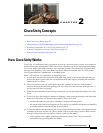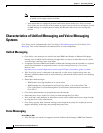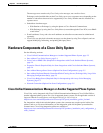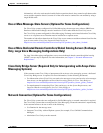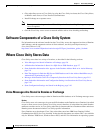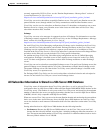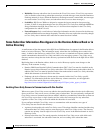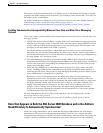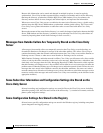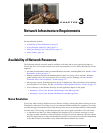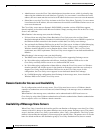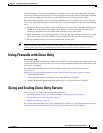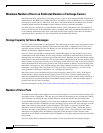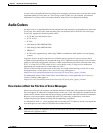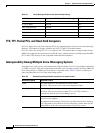
2-9
Design Guide for Cisco Unity Release 5.x
OL-14619-01
Chapter 2 Cisco Unity Concepts
Where Cisco Unity Stores Data
The directory replicates the information to all Domino servers in the domain (for Domino) or domain
controllers and global catalog servers in the forest (for Exchange), which ensures that Cisco
Unity has
the required access to information.
For detailed information on adding two or more Cisco Unity servers to the same Domino domain or
Active Directory forest, see the Networking Guide for Cisco
Unity at
http://www.cisco.com/en/US/products/sw/voicesw/ps2237/products_feature_guides_list.html.
Enabling Communication (Interoperability) Between Cisco Unity and Other Voice Messaging
Systems
Cisco Unity supports several methods for allowing communication between Cisco Unity and other voice
messaging systems:
• VPIM (Voice Profile for Internet Mail) is a digital protocol for transferring voice messages between
different voice messaging system. To send and receive voice messages by using VPIM, the customer
creates a delivery location object for each remote voice messaging system. The third-party voice
messaging server must adhere to the VPIM v2 protocol.
As with the primary location objects, which allow one Cisco Unity server to send messages to
subscribers who are associated with another Cisco
Unity server, delivery location objects contain
the information necessary for Cisco
Unity subscribers to exchange voice messages with people who
are using another voice messaging system.
• The Audio Messaging Interchange Specification analog (AMIS-a) protocol provides an analog
mechanism for transferring voice messages between different voice messaging systems. To send and
receive voice messages by using AMIS, the customer creates a delivery location object for each
remote voice messaging system.
• The Cisco Unity Bridge acts as a networking gateway between Cisco Unity servers and Octel
servers. The Bridge communicates with Octel servers by using the OctelNet analog protocol; it
communicates with Cisco
Unity servers by using the Digital Networking protocol, which is based
on the VPIM protocol, with proprietary extensions.
Because the servers use different protocols, the Bridge uses nodes to translate messages as
appropriate for each server. For the Octel node, the Cisco
Unity Bridge maintains a table that
contains the Octel server name, unique serial number, and phone number. For the Cisco
Unity node,
the Bridge maintains another table that contains the Cisco
Unity server name, assigned serial
number, and domain name. By using these two tables, the Cisco
Unity Bridge server can, for
example, receive a message from an Octel node, look up the routing information from the
Cisco
Unity node table, reformat the information for the destination Cisco Unity node, and then
send the message to the Cisco
Unity node.
For more information on how Cisco Unity works with other voice messaging systems, see the
Networking Guide for Cisco
Unity at
http://www.cisco.com/en/US/products/sw/voicesw/ps2237/products_feature_guides_list.html.
Data That Appears in Both the SQL Server 2000 Database and in the Address
Book/Directory Is Automatically Synchronized
Some Cisco Unity information is stored in both the SQL Server 2000 database and in the address
book/directory. This data can be changed both from within Cisco
Unity (for example, subscriber
information can be changed by using the Cisco
Unity Administrator), and from outside Cisco Unity (for
example, subscriber information can be changed by using Active Directory Users and Computers).



